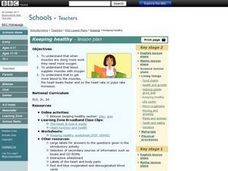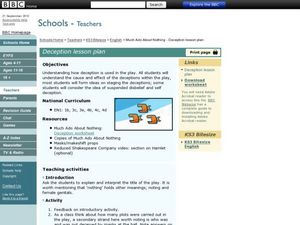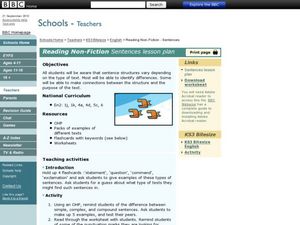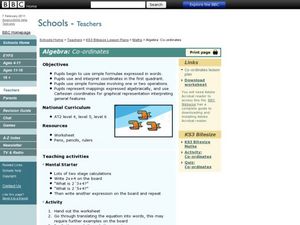Curated OER
Activity Plan 2-3: Baby Animals
Students get to be creative in learning about baby animals. In this early childhood lesson plan, students develop fine motor, math, and science skills as they sing, read, and share about baby animals.
Curated OER
Exploring Photographs
Students explore the basic tools for analyzing images using description, reflection, and formal analysis. In this photography analysis lesson plan, students analyze a photograph as a class and then in small groups. Students write...
Curated OER
Micro-organisms
Students learn what a micro-organism is. In this micro-organism lesson, students understand that micro-organisms may be too small to see. Students learn microorganisms could be bacteria, fungi, something beneficial or a harmful microbe....
Curated OER
Teeth and Eating
Students conduct online research of different animals and their diet. In this animal lesson, students identify the various types of diets each animals has and their teeth. This research is done on the Internet.
Curated OER
Magnets and Springs
Students explore magnetic attraction. In this magnets lesson, students participate in an interactive whiteboard activity in which objects are dragged onto a virtual table and categorized as to whether they are "repelled" or "attracted"...
Curated OER
Helping Plants Grow Well
Young scholars investigate the effect of water, temperature, and light on plant growth. In this plant lesson, students identify the parts of the plant and participate in an online activity. The website is included in this lesson plan.
Curated OER
Keeping Healthy Lesson Plan
Young scholars explore how muscles work. In this health lesson plan, students identify how the blood supplies muscles with oxygen. Young scholars participate in an online activity to reinforce the concepts.
Curated OER
Life Cycles
Students explore the parts of a flower and pollination of flowers. In this plants lesson, students use an interactive whiteboard to label the parts of a plant and the functions of each part. Students complete a worksheet as an assessment.
Curated OER
Current Issues Lesson 4: Local Police and Immigration Law: The Case of Special Order 40
Students examine immigration issues. In this immigration lesson, students prepare for a panel discussion regarding Special Order 40 in Los Angeles as they read an article regarding the order and role play local lobbyists in the panel...
Curated OER
Chemistry: Changing Materials
Students examine physical change with different temperature and solvents. In this elements and compounds lesson, students conduct experiments to discover what happens to the mass of a substance when is undergoes a physical change.
Curated OER
Deception Lesson Plan
Students explore Shakespeare's portrayal of deception. In this plot lesson plan, students examine the use of deception in "Much Ado About Nothing." Students write their own mini-versions of the play that are limited to 3 minutes.
Curated OER
Much Ado About Nothing Masks Lesson
Students examine the personality traits of characters. In this characterization lesson plan, students read act 2 of "Much Ado About Nothing" and create masks to represent the characters in the play.
Curated OER
Writing Sentences Lesson Plan
Young scholars explore first person and third person points of view. In this perspective lesson, students identify first person and third person points of view in literature they have read. Young scholars rewrite stories from different...
Curated OER
Writing Fiction lesson plan
Students compose a opening paragraph that sets the scene and foreshadows events. In this writing fiction lesson, students write an opening paragraph about a mugging and describe the scene in a way that foreshadows something bad is...
Curated OER
Reading Non-Fiction Sentences
Students identify differences in types of sentences. In this sentence structure lesson, students discuss the different ways sentences are written according to their intended audience. Students create different types sentences...
Curated OER
Algebra: Formulae
Students explore basic algebra formulas. For this introductory algebra lesson, student use basic algebra formulae to simplify expressions that include 1 or 2 operations.
Curated OER
Numbers: Rounding Off
Students discover the idea of rounding numbers. In this rounding lesson, students are given worksheets having to do with rounding whole numbers and fractions. Students participate in an activity with number flashcards.
Curated OER
Shape and Space: Circles
Students create isosceles triangles. In this triangles lesson, students participate in a quick fire exercise with combinations of numbers totaling 180. Students complete a worksheet with several problems.
Curated OER
Shape and Space: Symmetry
Students discuss and work with lines of symmetry. In this symmetry lesson plan, students start with a warm up activity on metric conversion. They talk about the definition of symmetry and reflection before completing a worksheet.
Curated OER
Reversible/Irreversible changes
Students observe an online activity where they see some solids dissolving and some not dissolving. In this dissolving lesson plan, students learn which solids will dissolve, melt, and which won't. They will also see which effects are...
Curated OER
99.86% - Measuring Our Sun's Mass
Learners determine just how large the sun is. In this solar system lesson plan, students follow the prescribed steps to draw a box that represents the size of the sun and its mass compared to the entire solar system.
Curated OER
Comments
Pupils evaluate newspaper articles. In this newspaper article lesson students compare newspaper articles. They comment on headlines, language choices, quality and clarity, and impact on the reader.
Curated OER
Characteristics of Materials
Students examine everyday materials by utilizing educational software. In this group analysis instructional activity, students identify several different fabrics and materials used in everyday life. Students participate in a computer...
Curated OER
Algebra: Co-ordinates
Students use Cartesian coordinates. In this graphing lesson students use simple formulae, interpret coordinates, and create graphical representations. They express their work algebraically.























